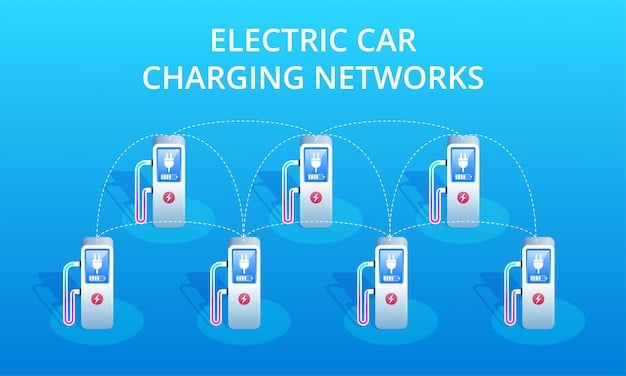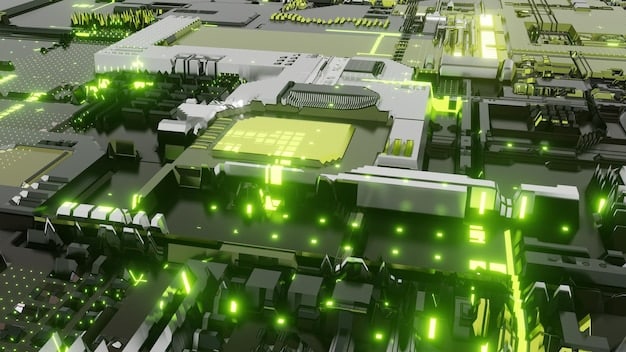The Future of V2G: Opportunities & Challenges for US Energy Storage

Vehicle-to-Grid (V2G) technology in the US energy storage sector shows great promise through bidirectional energy flow in electric vehicles, presenting opportunities for grid stabilization and cost savings, yet faces hurdles like infrastructure needs and regulatory frameworks.
The future of energy is rapidly evolving, and one of the most promising innovations is Vehicle-to-Grid (V2G) technology: Opportunities and Challenges for US Energy Storage. This technology has the potential to transform how we manage and distribute electricity, leveraging electric vehicles (EVs) as mobile energy storage units.
Understanding Vehicle-to-Grid (V2G) Technology
Vehicle-to-Grid (V2G) technology represents a paradigm shift in how electric vehicles interact with the power grid. Instead of merely drawing power from the grid, V2G enables EVs to both draw and supply electricity back to the grid, creating a bidirectional energy flow. This functionality opens up various opportunities for grid stabilization, energy management, and cost savings for both EV owners and utility companies.
How V2G Works
At its core, V2G technology relies on advanced charging infrastructure and sophisticated software to manage the flow of electricity between EVs and the grid. When an EV is connected to a V2G-enabled charging station, it can respond to signals from the grid operator to either charge or discharge electricity. This process is facilitated by inverters that convert the DC power stored in the EV battery to AC power suitable for the grid.
Key Components of a V2G System
A V2G system comprises several essential components, including bidirectional charging stations, communication networks, and grid management software. Bidirectional charging stations allow for the flow of electricity in both directions, while communication networks enable real-time data exchange between the EV, the charging station, and the grid operator. Grid management software optimizes the charging and discharging of EVs to meet the grid’s needs while minimizing the impact on EV battery life.
- Bidirectional Chargers: These chargers are crucial for enabling energy to flow both to and from the electric vehicle.
- Communication Networks: Ensures seamless data exchange and control between the EV, charging station, and grid operator.
- Grid Management Software: Optimizes the charging and discharging of EVs based on grid demands and user preferences.
The implementation of V2G technology requires a collaborative approach involving automakers, utility companies, technology providers, and regulatory bodies. Standards and protocols must be established to ensure interoperability and safety, and incentives may be needed to encourage EV owners to participate in V2G programs.
Potential Benefits of V2G Technology
The integration of V2G technology into the US energy infrastructure promises a multitude of benefits. From enhancing grid stability to creating new revenue streams, V2G has the potential to revolutionize the energy landscape. These advantages make it a focal point for future energy solutions.
Grid Stabilization
One of the most significant advantages of V2G is its ability to enhance grid stability. EVs can act as distributed energy resources, providing rapid response to fluctuations in supply and demand. By discharging electricity back to the grid during peak demand periods or when renewable energy sources are intermittent, V2G can help prevent blackouts and maintain a stable frequency.
Cost Savings
V2G technology can also lead to significant cost savings for both EV owners and utility companies. EV owners can earn revenue by participating in V2G programs, effectively turning their vehicles into mobile power plants. Utility companies can reduce their reliance on expensive peaking power plants by leveraging the energy storage capacity of EVs.

Supporting Renewable Energy Integration
The intermittent nature of renewable energy sources like solar and wind poses challenges for grid operators. V2G technology can help mitigate these challenges by providing a flexible energy storage solution. EVs can store excess renewable energy during periods of high generation and discharge it back to the grid when renewable output is low.
Ultimately, the deployment of V2G technology holds tremendous promise for creating a more resilient, sustainable, and cost-effective energy system in the United States. By harnessing the energy storage potential of electric vehicles, we can pave the way for a cleaner and more reliable energy future.
Challenges Facing V2G Technology in the US
Despite its immense potential, V2G technology faces several challenges that need to be addressed for widespread adoption in the United States. These challenges span technical, economic, and regulatory domains, each requiring innovative solutions and collaborative efforts.
Infrastructure Limitations
The current charging infrastructure in the US is not yet fully equipped to support V2G technology. Upgrading existing charging stations to enable bidirectional power flow and ensuring widespread availability of V2G-enabled chargers are essential steps. This requires significant investment and coordination among various stakeholders.
Regulatory and Policy Barriers
The regulatory landscape for V2G technology is still evolving, with unclear rules and regulations in many states. Establishing clear guidelines for energy trading, grid interconnection, and safety standards is crucial to foster investment and adoption. Policymakers need to create a supportive environment that encourages innovation and removes barriers to entry.
Economic Viability
The economic viability of V2G technology depends on various factors, including the cost of V2G-enabled chargers, the revenue potential for EV owners, and the value of grid services provided by EVs. Developing sustainable business models and incentive programs that benefit all stakeholders is essential to ensure the long-term success of V2G.
- High Initial Costs: The cost of bidirectional charging infrastructure can be a barrier for wide adoption.
- Uncertain Regulatory Environment: Lack of clear regulations can deter investment and participation.
- Battery Degradation Concerns: EV owners may worry about the impact of frequent charging and discharging on battery life.
Overcoming these challenges requires collaboration among government, industry, and research institutions. By addressing the technical, regulatory, and economic barriers, the US can unlock the full potential of V2G technology and accelerate the transition to a cleaner and more resilient energy future.
Technological Advancements Driving V2G
Ongoing technological advancements are playing a crucial role in driving the development and deployment of V2G technology. These innovations are addressing some of the key challenges and enhancing the performance, safety, and economic viability of V2G systems. From improved battery technology to advanced grid management software, progress is being made on multiple fronts.
Improved Battery Technology
Advancements in battery technology are leading to higher energy density, longer lifespans, and faster charging capabilities. These improvements are critical for V2G applications, as they enable EVs to store and discharge more energy with minimal degradation over time. Solid-state batteries and other next-generation technologies hold the promise of further enhancing the performance of V2G systems.
Smart Grid Integration
The integration of V2G technology with smart grids is enabling more efficient and reliable energy management. Smart grids use advanced sensors, communication networks, and control systems to optimize the flow of electricity and respond to real-time conditions. By incorporating V2G into smart grid infrastructure, grid operators can better manage the charging and discharging of EVs and leverage their energy storage capacity to enhance grid stability.

Cybersecurity Measures
As V2G technology becomes more integrated into the energy grid, cybersecurity becomes increasingly important. Protecting V2G systems from cyber threats is essential to ensure the reliability and security of the grid. Developing robust cybersecurity measures, including encryption, authentication, and intrusion detection systems, is crucial for mitigating the risks associated with V2G.
Moving forward, these technological advancements will continue to shape the future of V2G technology and accelerate its adoption in the US. By fostering innovation and collaboration, we can unlock the full potential of V2G and create a more sustainable and resilient energy system.
V2G Pilot Projects and Demonstrations in the US
Several pilot projects and demonstrations are underway in the United States to test and validate the feasibility and benefits of V2G technology. These initiatives are providing valuable insights into the technical, economic, and regulatory aspects of V2G and paving the way for wider deployment. By showcasing the potential of V2G in real-world settings, these projects are helping to build confidence and support among stakeholders.
California’s V2G Initiatives
California has been a leader in V2G research and development, with several pilot projects exploring the use of EVs for grid stabilization and energy management. These projects have demonstrated the ability of V2G to provide ancillary services to the grid, such as frequency regulation anddemand response. The results are informing policy decisions and helping to shape the future of V2G in the state.
University Research Programs
Various universities across the US are conducting research on V2G technology, focusing on areas such as battery management, grid integration, and cybersecurity. These research programs are contributing to a better understanding of the technical challenges and opportunities associated with V2G. The findings are being shared with industry and policymakers to accelerate the development and deployment of V2G technology.
Private Sector Investments
Private companies are also investing in V2G technology, developing new charging solutions, software platforms, and business models. These investments are helping to drive innovation and bring V2G solutions to market. Partnerships between automakers, utility companies, and technology providers are essential for creating a robust and sustainable V2G ecosystem.
The knowledge and experience gained from these pilot projects and demonstrations are essential for informing policy decisions, developing industry standards, and attracting investment in V2G technology. As more projects are launched and the results are analyzed, the path to widespread V2G adoption in the US will become clearer.
The Role of Policy and Incentives in V2G Adoption
Government policies and incentives play a crucial role in promoting the adoption of V2G technology. By creating a supportive regulatory environment, providing financial incentives, and investing in research and development, policymakers can accelerate the deployment of V2G and unlock its full potential. A well-designed policy framework is essential for attracting investment, fostering innovation, and ensuring that V2G benefits all stakeholders.
Regulatory Frameworks
Establishing clear and consistent regulatory frameworks for V2G is essential for creating a level playing field and reducing uncertainty. Policymakers need to address issues such as grid interconnection, energy trading, and data privacy. Standardizing protocols and ensuring interoperability are also important for enabling seamless integration of V2G into the grid.
Financial Incentives
Financial incentives can help to overcome the upfront cost barriers associated with V2G technology. Tax credits, rebates, and grants can encourage EV owners to participate in V2G programs and incentivize investment in V2G-enabled charging infrastructure. Performance-based incentives can also reward EV owners and aggregators for providing valuable grid services.
Public Awareness and Education
Raising public awareness and educating consumers about the benefits of V2G technology are crucial for building support and encouraging adoption. Public outreach campaigns, demonstration projects, and educational programs can help to inform consumers about the potential of V2G and address any misconceptions or concerns. Engaging with communities and stakeholders is essential for creating a shared vision for the future of V2G.
Ultimately, a comprehensive and well-coordinated policy approach is needed to realize the full potential of V2G technology in the US. By working together, government, industry, and research institutions can create a sustainable and equitable V2G ecosystem that benefits consumers, businesses, and the environment.
| Key Point | Brief Description |
|---|---|
| ⚡Grid Stabilization | V2G can rapidly respond to grid fluctuations, preventing blackouts. |
| 💰 Cost Savings | EV owners can earn revenue; utility companies reduce peaking plant reliance. |
| ☀️ Renewable Integration | Stores excess renewable energy, discharging when output is low. |
| 🚧 Challenges | Infrastructure limits, regulatory barriers, and economic viability concerns exist. |
Frequently Asked Questions (FAQ)
V2G technology allows electric vehicles to not only draw power from the grid but also send it back, creating a bidirectional energy flow. This can help stabilize the grid and reduce energy costs.
EV owners can earn revenue by participating in V2G programs, effectively turning their vehicles into mobile power plants. Additionally, they can save on energy costs.
Key challenges include infrastructure limitations, regulatory and policy barriers, and concerns about the economic viability of V2G systems for all stakeholders.
V2G helps manage the intermittent nature of renewable sources like solar and wind by storing excess energy when production is high and discharging it when needed.
Government policies and incentives are crucial for creating a supportive regulatory environment, providing financial incentives, and investing in V2G research and development.
Conclusion
The future of Vehicle-to-Grid (V2G) technology in the US energy storage sector holds immense potential. While challenges remain in infrastructure, regulations, and economic viability, ongoing technological advancements and supportive policies are paving the way for a more resilient, sustainable, and cost-effective energy system.





